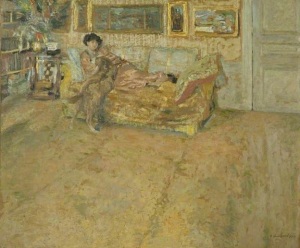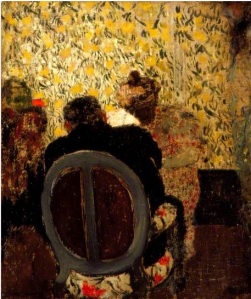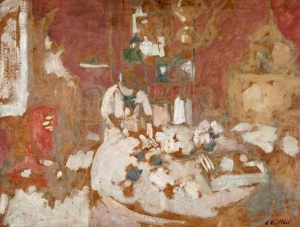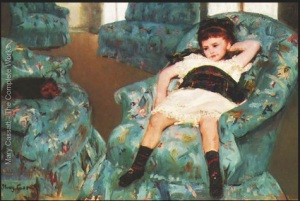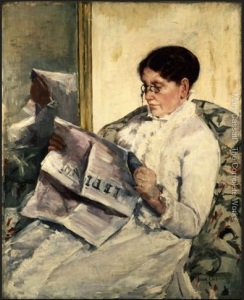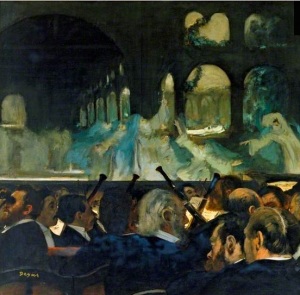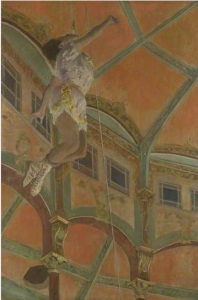Look at the work of Vuillard, Mary Cassatt and Degas and make notes on their approaches to composition.
Edouard Vuillard (1868 – 1940)
https://en.wikipedia.org/wiki/%C3%89douard_Vuillard (accessed 15/10/2015)
First, I looked at Vuillard’s interiors and how he has composed them to entice the viewer to look around the painting rather than just look at it.
In this image below, my immediate reaction to viewing it was from the bottom of the painting first then to the figures on the sofa. There is a large expanse of floor where Vuillard has painted lines that guide the viewer to the sofa. Once the eye is at the sofa there is a complex scene to unravel, to try to establish what is happening. The painting makes the viewer ask questions and is not boring to look at. It is a painting for the eye to linger over as there may be a little uncertainty as to what the painting is about, one glance will not tell all the story. The painting has a sense of calm about it, with the way he has used a limited colour pallet of cool colours. I like the way he has left a large amount of essentially emptiness and has used similar colours. The carpet, the dog and figure on the sofa all have very similar colours with no strong contrast colours.
http://www.bbc.co.uk/arts/yourpaintings/paintings/interior-with-madame-hessel-and-her-dog-189210 (accessed 15/10/2015)
This image below is completely different. The main element is right in the forefront, blocking the viewers view from what’s happening in the rest of the painting. You have to look around the seated figure and it made me curious to know what’s happening. The background has been lit up whilst the foreground is darker. My eye was taken straight to the lit background and the highlight on the second figure then around in a circular motion following the shape of the chair and the light.
http://www.bbc.co.uk/arts/yourpaintings/paintings/la-manicure-18041 (accessed 15/10/2015)
The image below is a good example of foreshortening. The vase of flowers has been placed in the foreground and the focus is on the left hand flower which is a little brighter than the others. The composition is balanced in that the main structure is at the bottom of the painting with the eye being led up to the vase of flowers to the highlighted ceiling. There is interest in the open space at the top with light fitting which has cast a small dark shadow created by lamp light that is not visible in the painting.
http://www.bbc.co.uk/arts/yourpaintings/paintings/la-partie-de-cartes-108077 (accessed 15/10/2015)
Again, the image below is a good example of foreshortening. The figure in the front is larger and darker than the figure in the middle ground. The middle ground figure has been partly obscured by shadow. Her face is darker than her clothes which seem to reflect the strong light coming from the right. Vuillard has again place the figure right in the foreground but hasn’t completely blocked the view. The light which is bouncing off the figures head leads the eye to look at the light on the green dress of the second figure then up to her face. I love this painting as it has an air of mystery about it as you can see the main figures face. This painting has taught me that not all elements of an object or figure needs to be seen. I don’t think the painting would have had the same impact if the mans face could have been seen.
http://www.bbc.co.uk/arts/yourpaintings/artists/jean-edouard-vuillard (accessed 15/10/2015)
I absolutely love this image. It is a great lesson in foreshortening, perspective and subtle tone. The eye is led down the length of the mantelpiece and falls off to look at the washing on the clothes airer. It is going from light to darker tones and then to a light tone. It is a bright, light image with the main darker tones in the centre which throws the eye out to the lighter surrounding areas. The white flowers and the other the items on the mantelpiece have been painted very delicately in comparison to the clothes on the airer which have more of an impressionistic treatment. There are lots of vertical lines which gives a sense of balance in that everything is ordered and calm.
http://www.bbc.co.uk/arts/yourpaintings/paintings/the-mantelpiece-la-cheminee-115738 (accessed 15/10/2015)
This final image below from Vuillard is very impressionistic. This painting is bathed in light and Vuillard has highlighted the areas where the light hits them in bright light tones. He has used minimal strokes, which are mainly gestural to describe forms. I really like that you can see a mirror in the back ground and he has drawn in a reflection, which looks to me like a man, it could be a self-portrait and he has captured himself whilst painting this picture. To me it is very clear that the figure is a woman and she is doing something at a table.
http://www.bbc.co.uk/arts/yourpaintings/paintings/the-table-86659 (accessed 15/10/2015)
Mary Cassatt (1844 – 1926)
Secondly, I looked at Mary Cassatt, an American painter and printmaker. http://www.marycassatt.org/biography.html (accessed (15/10/2015)
This artist was working in the same period as Vuillard and I can see similarities in composition. Cassatt has her own compositional style in that she mainly paints figures and from what I’ve seen, either single figures or mother daughter figures.
The image below shows the main subject in the foreground, with the figure facing the viewer which is more welcoming than a figure whose back is to the viewer. There is nothing to interpret in this image as it’s is quite clear what the painting is about. Cassatt has given the child light tones which brings the figure forward out of the painting. It is balanced by the well-lit windows in the background with the light spilling onto the floor. Cassatt has also balanced the figure by putting a dark band across the lightest area of the painting which seems to ground the figure on the chair, stopping it from floating away.
http://www.marycassatt.org/Little-Girl-in-a-Blue-Armchair,-1878.html (accessed 15/10/2015)
The image below is bright and light. The figure is lit from the right hand side with the darker areas over to the left in the mirror. The reflection in the mirror is darker than the sitter, and is a strong contrast between the two main areas of the painting. It is counter balanced with smaller pockets of dark areas in the newspaper, the furnishing fabric. If the sitters hair had been blonde, I don’t think the composition would have worked as well with the colours that Cassatt has used. The dark hair against the pale background pops out and I think is more of a focal point than the lighter areas.
http://www.marycassatt.org/Reading-Le-Figaro,-1878.html (accessed 15/10/2015)
The image below shows a typical scene that again leaves nothing to the imagination. My first reaction to this is to look directly at the mothers face, then to the refection in the mirror and then to the child, basically going from mid tone to dark tone to light tone. In contrast to the previous painting, the main focal point is the childs’ golden hair which has been made to ‘pop’ out by being surrounded with darker colours. There are a lot of vertical lines which give balance as the chair, wall coverings and mirror all have a symmetrical arrangement.
http://www.marycassatt.org/Mother-Combing-Her-Child’s-Hair,-c.1901.html (accessed 15/10/2015)
The image below is quite special. The main focal point is the young lady whose face is in a delicate shadow and the light is hitting off her shoulder and the left hand side of her face. Even though he face is in shadow her eyes are especially captivating because they are so dark against a basically light toned painting. The background is a reflection which has distorted the stalls in the theatre but not the reflection of the young lady. The painting is balanced by the dark flower, the fan and the figures in the stalls.
http://www.marycassatt.org/Woman-In-A-Loge.html
Edgar Degas (1834 – 1917)
Degas has composed the image below with the main interest in the foreground. He has painted the orchestra in great detail and has made the middle and foreground impressionistic. The mid ground has light tones against the very dark background. He has a rhythm and symmetry flowing through the painting as the direction and angles of the instruments matches the direction and angles of the dancers.
http://www.bbc.co.uk/arts/yourpaintings/paintings/the-ballet-scene-from-meyerbeers-opera-robert-le-diable-30908 (accessed 15/10/2015)
I like this image where Degas has brought the studio right into the foreground by making the spiral staircase the focal point. The dancers seem secondary to the stairs which I think anchors the painting. There is lots of movement throughout the painting in that the dancers are obviously in mid movement and the spiral of the staircase kind of flows upwards out of the painting. The foreground floor is an empty area where there is no focus, which allows the eye to look into the background to the dancers. I like the way there are directional lines that follow the different elements of the painting. The diagonal pattern of the floorboards are echoed in the direction of the dancer’s bodies and feet.
http://www.bbc.co.uk/arts/yourpaintings/paintings/the-rehearsal-83736 (accessed 15/10/2015)
This image shows foreshortening and perspective. The viewpoint is from below looking up towards the figure. There is hardly anything that is impressionistic in this painting but your eye is immediately drawn to the suspended figure. It has been lit from underneath making the torso the focal point. Degas has used angular lines to give a flow from bottom left to top right with the figures arms and feet following the lines of the beams of the roof. The proportion and perspective of the windows suggest that the building is circular.
http://www.bbc.co.uk/arts/yourpaintings/paintings/miss-la-la-at-the-cirque-fernando-114759 (accessed 15/10/2015)
